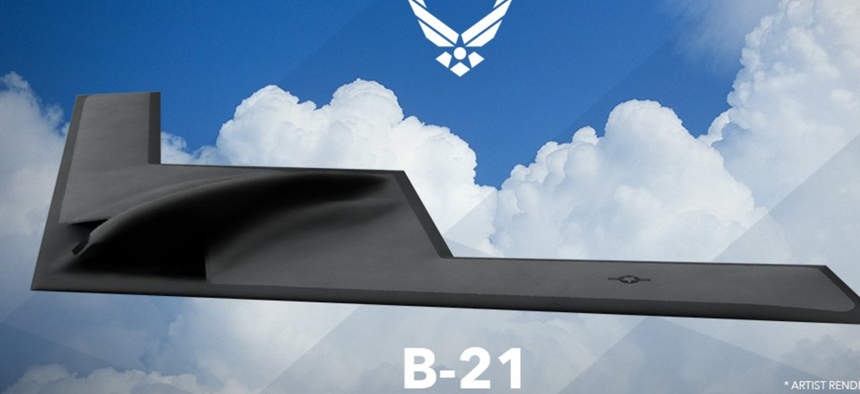
U.S. Air Force artist rendering of B-21 Raider U.S. Air Force
The US Air Force Needs More Bombers Than It's Asking For
The only problem with the B-21 Raider acquisition strategy is that the minimum purchase should be 164 of the stealthy jets, not 100.
In a future combat zone dominated by advanced 3-D air search radars, directed-energy weapons, electromagnetic railguns, and hypersonic missiles, there is still room — indeed, a strong requirement — for the new B-21 heavy bomber. Analysis suggests that the United States needs a lot of them, far more than the 100 new bombers the Air Force currently desires.
To prosecute a major, sustained long-range strike campaign within an anti-access/area denial environment dominated by China’s HQ-9 or Russia’s S-400 missiles, the Air Force needs to add a minimum of 164 B-21 bombers to the nation’s older but nonetheless relevant B-52 Stratofortress and B-2 Spirit stealth bombers. This is because heavy bombers, whose form and function have been honed in hot and cold wars over a century, can perform missions and hit targets that no other platform can. (Find a detailed explanation for this determination in “Higher, Heavier, Farther, and now Undetectable?”, my recent report written with Air Force Lt. Col. James Price and published by the Center for a New American Security.)
The specific design characteristics of the B-21 remain hidden and undiscussed beyond a conceptual photo and models, but the evolution of heavy bombers points towards certain attributes that most certainly will be present. First, it will be able to fly a long distance. The bomber came into existence in World War I precisely because its larger frame could carry more fuel and hence fly farther to hit critical targets behind enemy lines. The B-21 Raider, when combined with the Air Force’s tanker fleet, will have the range to hit targets anywhere in the world. It will also have the ability to carry a heavy load of ordnance. This was another lesson of the Great War, whose aircrews discovered that it took many bombs of ever-increasing size to take out targets. And while the advent of precision strike weapons rendered moot the 1970s-era requirement for the B-1B Lancer to carry 40 tons of bombs — we no longer need to carpet-bomb a location to ensure the destruction of a target — the size of weapons remains relevant. The B-21 will need to be able to carry the 30,000-pound GBU-57 Massive Ordnance Penetrator and most likely will have a total magazine capacity of around 20 tons. Finally, the development of the Joint Strike Fighter as a passive/active sensor integrator also suggests that the B-21 will have a highly capable data-gathering capacity.
The true game-changer with regard to modern bombers is that they will no longer operate in massive formations as in the classic movie “Twelve O’Clock High.” There is no need. The B-21’s range, combined with its ability to carry a lot of weapons of different types and sizes, will enable it to strike a host of geographically dispersed targets in a single mission. In the past, the United States would have to first deploy a reconnaissance asset to ascertain a target’s location, then vector a bomber to hit it. The B-21 will be able to do both at once.
There are some characteristics of previous bombers that we will not see in the B-21. It will not fly has high (80,000 feet) or as fast (1,700 mph) as the 1960s’ experimental B-70 Valkyrie. We now know through hard-won experience that an aircraft can neither out-climb nor out-race a surface-to-air missile. Rather, the B-21 will take advantage of the most revolutionary characteristic of modern bombers: their ability to disappear. Technicians who tested early flying-wing designs during the 1940s noted that they were very difficult to spot both visually and by early radar. This insight came to maturity during the 1990s with the introduction of the B-2 stealth bomber. Whereas the older B-52 has a radar cross section of 100 square meters, about the size of the side of a barn, the B-2’s RCS is orders of magnitude smaller, the size of a small insect. This allows the Spirit, and will allow the future B-21, to sit undetected in the middle of the battle space.
This is of crucial importance. After the demise of the Soviet Union, the Air Force made a strategic bet on shorter-ranged aircraft that would operate from bases relatively close to its targets and in fairly permissive environments. Instead, Russia and China have made massive investments in anti-access/area denial radars and missiles intended to keep American aircraft far away from their targets. The B-21, then, will restore the U.S. military’s ability to fly strike missions in heavily defended areas.
The only difficulty with the Air Force’s B-21 acquisition strategy is that service leaders do not plan to buy enough. Perhaps in an effort to allay fears of runaway program costs, Air Force leaders originally announced that they planned to buy “80 to 100” of the new bombers. Later, they said the goal was “100 aircraft.” However, there was no underlying strategic basis given for the number beyond adherence to a budgetary cap. Analysis of peacetime air-presence missions and wartime campaign plans suggest that the air service requires a minimum of 164 aircraft and possibly a lot more, depending upon how and where they plan to use older bombers in A2/AD environments.
The B-21 Raider, with its range, endurance, weapons capacity, passive sensors and stealth characteristics, represents nearly a century of refined lessons learned and brings balance back to the nation’s air power inventory. It serves to re-establish a credible deterrent threat to keep the peace and regain the strategic initiative for our nation.




